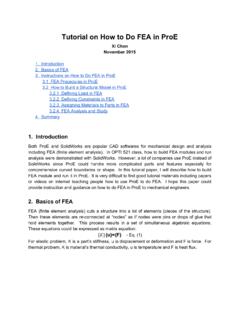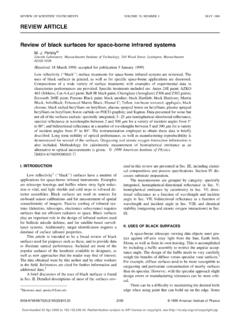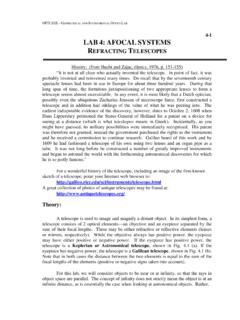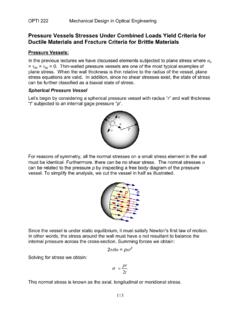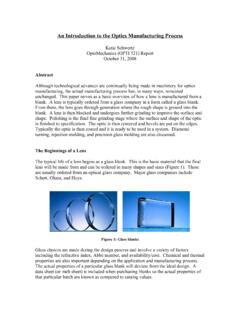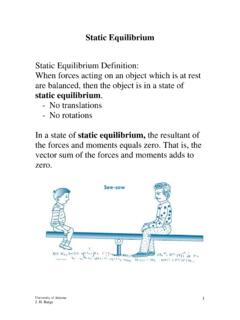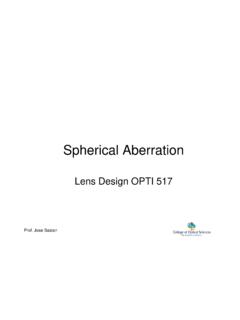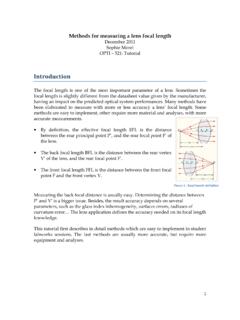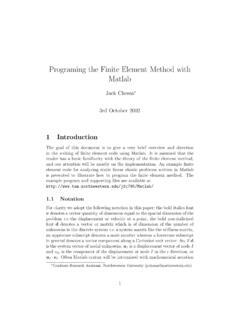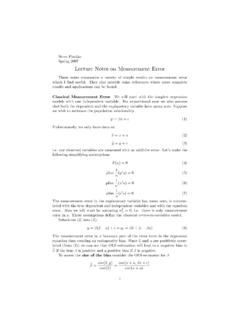Transcription of Zernike Polynomials - University of Arizona
1 Zernike Polynomials1 IntroductionOften, to aid in the interpretation of optical test results it is convenient to express wavefront data in polynomial form. Zernike Polynomials are often used for thispurpose since they are made up of terms that are of the same form as the types of aberrations often observed in optical tests ( Zernike , 1934). This is not to say thatZernike Polynomials are the best Polynomials for fitting test data. Sometimes Zernike Polynomials give a poor representation of the wavefront data. For example,Zernikes have little value when air turbulence is present. Likewise, fabrication errors in the single point diamond turning process cannot be represented using areasonable number of terms in the Zernike polynomial.
2 In the testing of conical optical elements, additional terms must be added to Zernike Polynomials to accuratelyrepresent alignment errors. The blind use of Zernike Polynomials to represent test results can lead to disastrous Polynomials are one of an infinite number of complete sets of Polynomials in two variables, r and q, that are orthogonal in a continuous fashion over the interiorof a unit circle. It is important to note that the Zernikes are orthogonal only in a continuous fashion over the interior of a unit circle, and in general they will not beorthogonal over a discrete set of data points within a unit Polynomials have three properties that distinguish them from other sets of orthogonal Polynomials . First, they have simple rotational symmetry properties thatlead to a polynomial product of the formr@ Dg@ D,where g[q] is a continuous function that repeats self every 2p radians and satisfies the requirement that rotating the coordinate system by an angle a does not change theform of the polynomial.
3 That isg@ + D=g@ Dg@ set of trigonometric functionsg@ D= m ,where m is any positive integer or zero, meets these second property of Zernike Polynomials is that the radial function must be a polynomial in r of degree 2n and contain no power of r less than m. The third propertyis that r[r] must be even if m is even, and odd if m is radial Polynomials can be derived as a special case of Jacobi Polynomials , and tabulated as Their orthogonality and normalization properties are givenby 01 r@n,m, D r@n',m, D =1ccccccccccccccccccccc2 Hn+1L KroneckerDelta@n n' C. Wyant, stated above, r[n, m, r] is a polynomial of order 2n and it can be written asr@n_, m_, _D:= s=0n mH 1Ls H2 n m sL!ccccccccccccccccccccccccccccccccccccc cccccccccccccccccccccs!
4 Hn sL! Hn m sL! 2 Hn sL mIn practice, the radial Polynomials are combined with sines and cosines rather than with a complex exponential. It is convenient to writercos@n_, m_, _D:=r@n, m, DCos@m Dandrsin@n_, m_, _D:=r@n, m, DSin@m DThe final Zernike polynomial series for the wavefront opd Dw can be written as w@ _, _D:= w + n=1nmaxikjjjjja@nDr@n, 0, D+ m=1nHb@n, mDrcos@n, m, D+c@n, mDrsin@n, m, DLy{zzzzzwhere Dw[r, q] is the mean wavefront opd, and a[n], b[n,m], and c[n,m] are individual polynomial coefficients. For a symmetrical optical system, the wave aberrationsare symmetrical about the tangential plane and only even functions of q are allowed. In general , however, the wavefront is not symmetric, and both sets of trigonometricterms are Calculating ZernikesFor the example below the degree of the Zernike Polynomials is selected to be 6.}
5 The value of nDegree can be changed if a different degree is array zernikePolar contains Zernike Polynomials in polar coordinates (r, q), while the array zernikeXy contains the Zernike Polynomials in Cartesian, (x, y),coordinates. zernikePolarList and zernikeXyList contains the Zernike number in column 1, the n and m values in columns 2 and 3, and the Zernike polynomial incolumn 4. nDegree=6;i=0;Do@If@m==0,8i=i+1, temp@iD=8i 1, n, m, r@n, m, D<<,8i=i+1, temp@iD=8i 1, n, m, Factor@rcos@n, m, DD<,i=i+1, temp@iD=8i 1, n, m, Factor@rsin@n, m, DD<<D,8n, 0, nDegree<,8m, n, 0, 1<D; C. Wyant, 20032zernikePolarList=Array@temp, iD;Clear@tempD;Do@zernikePolar@i 1D=zernikePolarList@@i, 4DD,8i, 1, Length@zernikePolarListD<D;zernikeXyList =Map@TrigExpand, zernikePolarListD.
6 9 !!!!!!!!!!!!!!!x2+y2, Cos@ D xcccccccccccccccccccccc !!!!!!!!!!!!!!!x2+y2, Sin@ D ycccccccccccccccccccccc !!!!!!!!!!!!!!!x2+y2=;Do@zernikeXy@i 1D=zernikeXyList@@i, 4DD,8i, 1, Tables of ZernikesIn the tables term # 1 is a constant or piston term, while terms # 2 and # 3 are tilt terms. Term # 4 represents focus. Thus, terms # 2 through # 4 represent the Gaussianor paraxial properties of the wavefront. Terms # 5 and # 6 are astigmatism plus defocus. Terms # 7 and # 8 represent coma and tilt, while term # 9 represents third-order spherical and focus. Likewise terms # 10 through # 16 represent fifth-order aberration, terms # 17 through # 25 represent seventh-order aberrations, terms # 26through # 36 represent ninth-order aberrations, and terms # 37 through # 49 represent eleventh-order term contains the appropriate amount of each lower order term to make it orthogonal to each lower order term.
7 Also, each term of the Zernikes minimizes the rmswavefront error to the order of that term. Adding other aberrations of lower order can only increase the rms error. Furthermore, the average value of each term over theunit circle is Zernikes in polar coordinatesTableForm@zernikePolarList, TableHeadings >88<,8"#", "n", "m", "Polynomial"<<D# n m Polynomial0 001111 Cos@ D211 Sin@ D310 1+2 2422 2 Cos@2 D522 2 Sin@2 D621 H 2+3 2 LCos@ D721 H 2+3 2 LSin@ D8 201 6 2+6 4933 3 Cos@3 D10 3 3 3 Sin@3 C. Wyant, 2003311 3 2 2H 3+4 2 LCos@2 D12 3 2 2H 3+4 2 LSin@2 D13 3 1 H3 12 2+10 4 LCos@ D14 3 1 H3 12 2+10 4 LSin@ D15 3 0 1+12 2 30 4+20 616 4 4 4 Cos@4 D17 4 4 4 Sin@4 D18 4 3 3H 4+5 2 LCos@3 D19 4 3 3H 4+5 2 LSin@3 D20 4 2 2H6 20 2+15 4 LCos@2 D21 4 2 2H6 20 2+15 4 LSin@2 D22 4 1 H 4+30 2 60 4+35 6 LCos@ D23 4 1 H 4+30 2 60 4+35 6 LSin@ D24401 20 2+90 4 140 6+70 825 5 5 5 Cos@5 D26 5 5 5 Sin@5 D27 5 4 4H 5+6 2 LCos@4 D28 5 4 4H 5+6 2 LSin@4 D29 5 3 3H10 30 2+21 4 LCos@3 D30 5 3 3H10 30 2+21 4 LSin@3 D31 5 2 2H 10+60 2 105 4+56 6 LCos@2 D32 5 2 2H 10+60 2 105 4+56 6 LSin@2 D33 5
8 1 H5 60 2+210 4 280 6+126 8 LCos@ D34 5 1 H5 60 2+210 4 280 6+126 8 LSin@ D35 5 0 1+30 2 210 4+560 6 630 8+252 1036 6 6 6 Cos@6 D37 6 6 6 Sin@6 D38 6 5 5H 6+7 2 LCos@5 D39 6 5 5H 6+7 2 LSin@5 D40 6 4 4H15 42 2+28 4 LCos@4 D41 6 4 4H15 42 2+28 4 LSin@4 D42 6 3 3H 20+105 2 168 4+84 6 LCos@3 D43 6 3 3H 20+105 2 168 4+84 6 LSin@3 D44 6 2 2H15 140 2+420 4 504 6+210 8 LCos@2 D45 6 2 2H15 140 2+420 4 504 6+210 8 LSin@2 C. Wyant, 2003446 6 1 H 6+105 2 560 4+1260 6 1260 8+462 10 LCos@ D47 6 1 H 6+105 2 560 4+1260 6 1260 8+462 10 LSin@ D48601 42 2+420 4 1680 6+3150 8 2772 10+924 Zernikes in Cartesian coordinatesTableForm@zernikeXyList, TableHeadings >88<,8"#", "n", "m".
9 "Polynomial"<<D# n m Polynomial0001111x211y310 1+2Hx2+y2L422x2 y25 2 2 2xy621 2x+3xHx2+y2L721 2y+3yHx2+y2L8201 6Hx2+y2L+6Hx2+y2L2933x3 3xy210 3 3 3 x2y y311 3 2 3x2+3y2+4x2Hx2+y2L 4y2Hx2+y2L12 3 2 6xy+8xyHx2+y2L13 3 1 3 x 12 xHx2+y2L+10 xHx2+y2L214 3 1 3 y 12 yHx2+y2L+10 yHx2+y2L215 3 0 1+12Hx2+y2L 30Hx2+y2L2+20Hx2+y2L316 4 4 x4 6x2y2+y417 4 4 4 x3y 4xy318 4 3 4x3+12 x y2+5x3Hx2+y2L 15 x y2Hx2+y2L19 4 3 12 x2y+4y3+15 x2yHx2+y2L 5y3Hx2+y2L20 4 2 6 x2 6y2 20 x2Hx2+y2L+20 y2Hx2+y2L+15 x2Hx2+y2L2 15 y2Hx2+y2L221 4 2 12 x y 40 x yHx2+y2L+30 x yHx2+y2L222 4 1 4x+30 xHx2+y2L 60 xHx2+y2L2+35 xHx2+y2L323 4 1 4y+30 yHx2+y2L 60 yHx2+y2L2+35 yHx2+y2L324 4 0 1 20Hx2+y2L+90Hx2+y2L2 140Hx2+y2L3+70Hx2+y2L425 5 5 x5 10 x3y2+5xy426 5 5 5 x4y 10 x2y3+y527 5 4 5x4+30 x2y2 5y4+6x4Hx2+y2L 36 x2y2Hx2+y2L+6y4Hx2+y2L28 5 4 20 x3y+20 x y3+24 x3yHx2+y2L 24 x y3Hx2+y2L29 5 3 10 x3 30 x y2 30 x3Hx2+y2L+90 x y2Hx2+y2L+21 x3Hx2+y2L2 63 x y2Hx2+y2L230 5 3 30 x2y 10 y3 90 x2yHx2+y2L+30 y3Hx2+y2L+63 x2yHx2+y2L2 21 y3Hx2+y2L231 5 2 10 x2+10 y2+60 x2Hx2+y2L 60 y2Hx2+y2L 105 x2Hx2+y2L2+105 y2Hx2+y2L2+56 x2Hx2+y2L3 56 y2Hx2+y2L332 5 2 20 x y+120 x yHx2+y2L 210 x yHx2+y2L2+112 x yHx2+y2L333 5 1 5 x 60 xHx2+y2L+210 xHx2+y2L2 280
10 XHx2+y2L3+126 xHx2+y2L434 5 1 5 y 60 yHx2+y2L+210 yHx2+y2L2 280 yHx2+y2L3+126 yHx2+y2L435 5 0 1+30Hx2+y2L 210Hx2+y2L2+560Hx2+y2L3 630Hx2+y2L4+252Hx2+y2L536 6 6 x6 15 x4y2+15 x2y4 y637 6 6 6 x5y 20 x3y3+6xy538 6 5 6x5+60 x3y2 30 x y4+7x5Hx2+y2L 70 x3y2Hx2+y2L+35 x y4Hx2+y2L39 6 5 30 x4y+60 x2y3 6y5+35 x4yHx2+y2L 70 x2y3Hx2+y2L+7y5Hx2+y2L40 6 4 15 x4 90 x2y2+15 y4 42 x4Hx2+y2L+252 x2y2Hx2+y2L 42 y4Hx2+y2L+28 x4Hx2+y2L2 168 x2y2Hx2+y2L2+28 y4Hx2+ C. Wyant, 2003541 6 4 60 x3y 60 x y3 168 x3yHx2+y2L+168 x y3Hx2+y2L+112 x3yHx2+y2L2 112 x y3Hx2+y2L242 6 3 20 x3+60 x y2+105 x3Hx2+y2L 315 x y2Hx2+y2L 168 x3Hx2+y2L2+504 x y2Hx2+y2L2+84 x3Hx2+y2L3 252 x y2Hx2+y2L343 6 3 60 x2y+20 y3+315 x2yHx2+y2L 105 y3Hx2+y2L 504 x2yHx2+y2L2+168 y3Hx2+y2L2+252 x2yHx2+y2L3 84 y3Hx2+y2L344 6 2 15 x2 15 y2 140 x2Hx2+y2L+140 y2Hx2+y2L+420 x2Hx2+y2L2 420 y2Hx2+y2L2 504 x2Hx2+y2L3+504 y2Hx2+y2L3+210 x2Hx2+y2L4 210 y2Hx2+y2L445 6 2 30 x y 280 x yHx2+y2L+840 x yHx2+y2L2 1008 x yHx2+y2L3+420 x yHx2+y2L446 6 1 6x+105 xHx2+y2L 560 xHx2+y2L2+1260 xHx2+y2L3 1260 xHx2+y2L4+462 xHx2+y2L547 6 1 6y+105 yHx2+y2L 560 yHx2+y2L2+1260 yHx2+y2L3 1260 yHx2+y2L4+462
